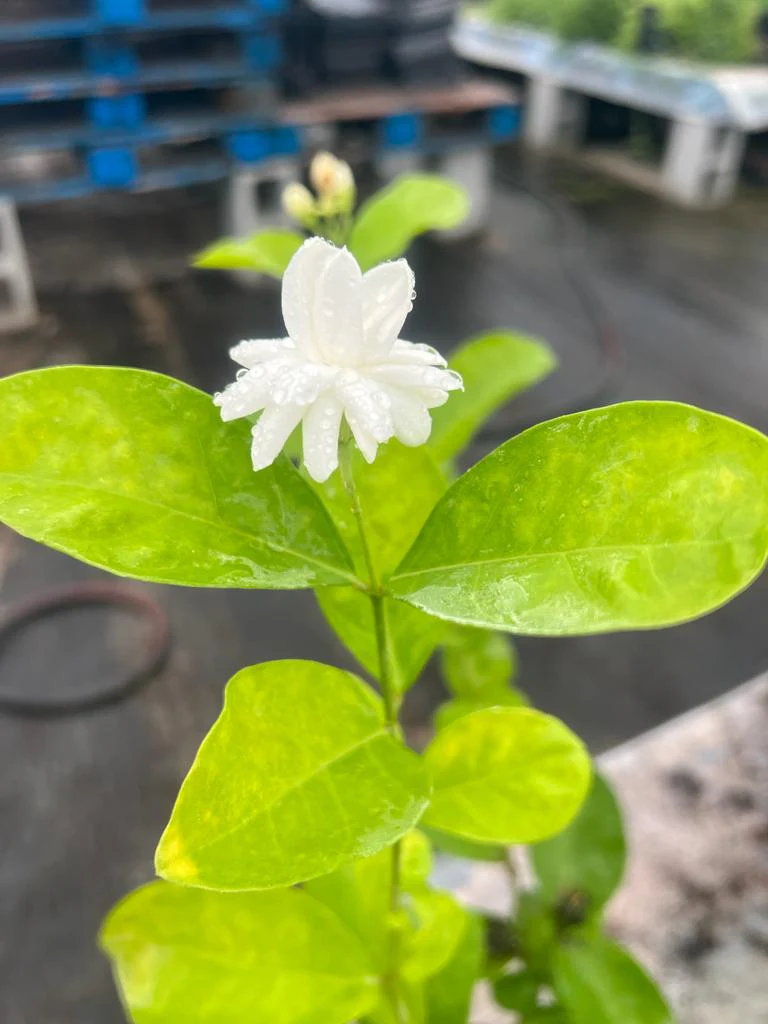
Belle of India Jasmine: A Radiant and Fragrant Beauty
Discover the allure of Belle of India Jasmine – a stunning and intensely fragrant climber with large white double-star-shaped flowers. Belle of India Jasmine (Jasminum sambac ‘Belle of India’) is a stunning and intensely fragrant evergreen climber, cultivated for its exceptional beauty and scent. This lovely plant boasts:
- Dark green, glossy leaves with a leathery texture
- Large, white, double-star-shaped flowers with a powerful, sweet fragrance
- Long, slender stems with a twining habit, perfect for trellises or arbors
Fragrance and Bloom:
- Belle of India Jasmine blooms in the evening, releasing its heady scent into the night air
- The fragrance is intense and sweet, with hints of rose and orange blossom
Unique Characteristics:
- Larger flowers than other Jasmine varieties
- Double-star shape adds to its exotic beauty
- More compact growth habit, ideal for containers or smaller gardens
Uses and Significance:
- Used in perfumes, aromatherapy, and traditional medicine
- A popular choice for gardens, greenhouses, and indoor containers
- Symbolizes love, sensuality, and spiritual growth in various cultures
Here’s a comprehensive care guide for “Belle of India” (Jasminum sambac ‘Belle of India’), a popular, compact Arabian Jasmine variety:
Lighting
- Bright, indirect sunlight (4-6 hours/day)
- East- or west-facing windows ideal
- Avoid direct sunlight, which can cause leaf scorch
Watering
- Consistent moisture, avoiding overwatering
- Water when top 1-2 inches of soil feels dry
- Reduce watering in winter months (Oct-Feb)
Soil
- Well-draining soil with pH 6.0-7.0
- Mix organic matter like compost or perlite for improved drainage
Temperature
- Ideal temperature range: 65°F-90°F (18°C-32°C)
- Avoid temperatures below 55°F (13°C) or above 100°F (38°C)
Fertilization
- Balanced fertilizer (10-10-10 NPK) during growing season (Mar-Sep)
- Dilute fertilizer to half recommended strength for young plants
Pruning
- Prune after flowering to promote new growth
- Remove spent flowers and trim back stems
Humidity
- Maintain 50-60% humidity around plants
- Mist plants regularly, especially during dry periods
Pest and Disease Management
- Watch for pests: mealybugs, spider mites, scale
- Inspect for diseases: root rot, leaf spot, powdery mildew
- Use organic pest control methods whenever possible
Propagation
- Stem cuttings: Take 3-4 inch cuttings, remove lower leaves, plant in moist soil
- Layering: Bend stems to ground, secure with rocks, and cover with soil
Repotting
- Transplant every 2-3 years to refresh soil and promote healthy growth
- Choose pots with good drainage
Special Care
- Provide support: Train stems to grow upright or use trellis
- Monitor pH levels: Maintain slightly acidic to neutral soil pH
Common Issues
- Leaf drop: Overwatering, underwatering, or temperature fluctuations
- No flowering: Insufficient light, inadequate fertilization, or root bound
Fun Facts
- “Belle of India” is a compact, flowering variety of Arabian Jasmine
- Its fragrance is used in perfumes, teas, and traditional medicine
By following these guidelines, you’ll be able to provide optimal care for your “Belle of India” plant. Happy gardening!



